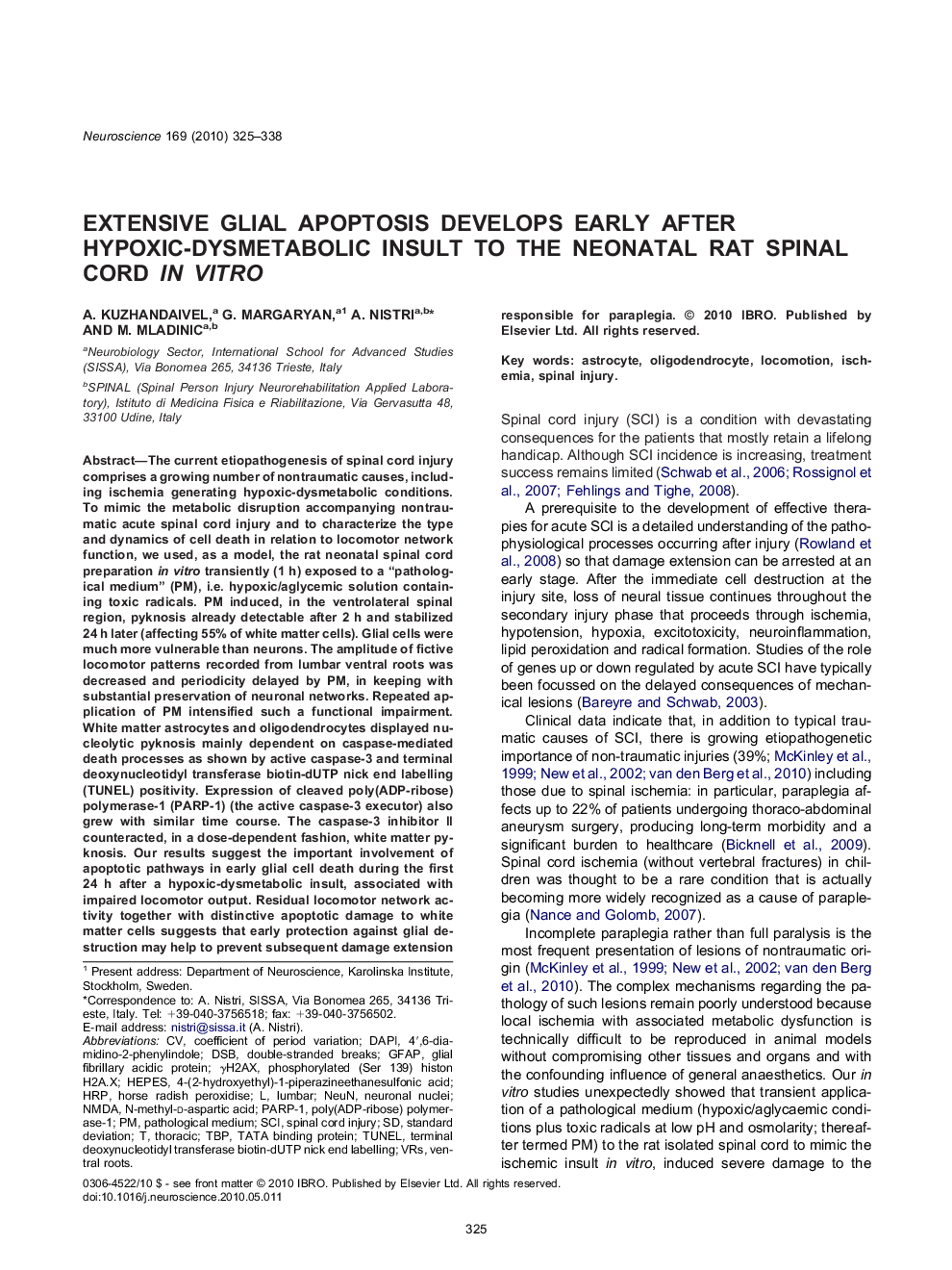| کد مقاله | کد نشریه | سال انتشار | مقاله انگلیسی | نسخه تمام متن |
|---|---|---|---|---|
| 4339432 | 1295753 | 2010 | 14 صفحه PDF | دانلود رایگان |
عنوان انگلیسی مقاله ISI
Extensive glial apoptosis develops early after hypoxic-dysmetabolic insult to the neonatal rat spinal cord in vitro
دانلود مقاله + سفارش ترجمه
دانلود مقاله ISI انگلیسی
رایگان برای ایرانیان
کلمات کلیدی
NeuNventral rootsγH2AXVRSN-methyl-d-aspartic acidNMDADSBDAPIPARP-1HRPHEPESTBPGFAP4′,6-diamidino-2-phenylindole - 4 '، 6-دیامیدینو-2-فنیلینول4-(2-hydroxyethyl)-1-piperazineethanesulfonic acid - 4- (2-hydroxyethyl) -1-piperazineethanesulfonic acidAstrocyte - آستروسیتSpinal injury - آسیب نخاعیSpinal cord injury - آسیب نخاعیOligodendrocyte - الیگودندروسیتstandard deviation - انحراف معیارIschemia - ایسکمیTUNEL - تونلLocomotion - حرکتdouble-stranded breaks - شکاف دو رشتهsci - علمیThoracic - قفسه سینهlumbar - لامبار، ناحیهٔ کمرneuronal nuclei - هسته های نورونیGlial fibrillary acidic protein - پروتئین اسیدی فیبریلاسیون گلایالTATA binding protein - پروتئین متصل به TATAPoly(ADP-ribose) polymerase-1 - پلی (ADP-ribose) پلیمراز-1
موضوعات مرتبط
علوم زیستی و بیوفناوری
علم عصب شناسی
علوم اعصاب (عمومی)
پیش نمایش صفحه اول مقاله

چکیده انگلیسی
The current etiopathogenesis of spinal cord injury comprises a growing number of nontraumatic causes, including ischemia generating hypoxic-dysmetabolic conditions. To mimic the metabolic disruption accompanying nontraumatic acute spinal cord injury and to characterize the type and dynamics of cell death in relation to locomotor network function, we used, as a model, the rat neonatal spinal cord preparation in vitro transiently (1 h) exposed to a “pathological medium” (PM), i.e. hypoxic/aglycemic solution containing toxic radicals. PM induced, in the ventrolateral spinal region, pyknosis already detectable after 2 h and stabilized 24 h later (affecting 55% of white matter cells). Glial cells were much more vulnerable than neurons. The amplitude of fictive locomotor patterns recorded from lumbar ventral roots was decreased and periodicity delayed by PM, in keeping with substantial preservation of neuronal networks. Repeated application of PM intensified such a functional impairment. White matter astrocytes and oligodendrocytes displayed nucleolytic pyknosis mainly dependent on caspase-mediated death processes as shown by active caspase-3 and terminal deoxynucleotidyl transferase biotin-dUTP nick end labelling (TUNEL) positivity. Expression of cleaved poly(ADP-ribose) polymerase-1 (PARP-1) (the active caspase-3 executor) also grew with similar time course. The caspase-3 inhibitor II counteracted, in a dose-dependent fashion, white matter pyknosis. Our results suggest the important involvement of apoptotic pathways in early glial cell death during the first 24 h after a hypoxic-dysmetabolic insult, associated with impaired locomotor output. Residual locomotor network activity together with distinctive apoptotic damage to white matter cells suggests that early protection against glial destruction may help to prevent subsequent damage extension responsible for paraplegia.
ناشر
Database: Elsevier - ScienceDirect (ساینس دایرکت)
Journal: Neuroscience - Volume 169, Issue 1, 11 August 2010, Pages 325-338
Journal: Neuroscience - Volume 169, Issue 1, 11 August 2010, Pages 325-338
نویسندگان
A. Kuzhandaivel, G. Margaryan, A. Nistri, M. Mladinic,